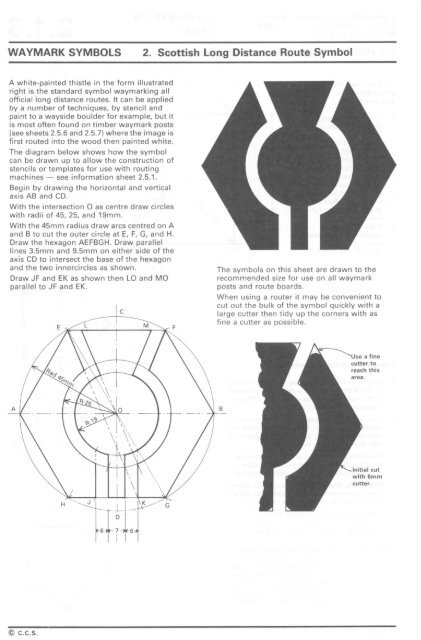information - Scottish Natural Heritage
information - Scottish Natural Heritage
information - Scottish Natural Heritage
Create successful ePaper yourself
Turn your PDF publications into a flip-book with our unique Google optimized e-Paper software.
WAYMARK SYMBOLS 2. <strong>Scottish</strong> Long Distance Route Symbol<br />
A white-painted thistle in the form illustrated<br />
right is the standard symbol waymarking all<br />
official long distance routes. It can be applied<br />
by a number of techniques, by stencil and<br />
paint to a wayside boulder for example, but it<br />
is most often found on timber waymark posts<br />
(see sheets 2.5.6 and 2.5.7) where the image is<br />
first routed into the wood then painted white.<br />
The diagram below shows how the symbol<br />
can be drawn up to allow the construction of<br />
stencils or templates for use with routing<br />
machines — see <strong>information</strong> sheet 2.5.1.<br />
Begin by drawing the horizontal and vertical<br />
axis AB and CD.<br />
With the intersection O as centre draw circles<br />
with radii of 45, 25, and 19mm.<br />
With the 45mm radius draw arcs centred on A<br />
and B to cut the outer circle at E, F, G, and H.<br />
Draw the hexagon AEFBGH. Draw parallel<br />
lines 3.5mm and 9.5mm on either side of the<br />
axis CD to intersect the base of the hexagon<br />
and the two innercircles as shown.<br />
Draw JF and EK as shown then LO and MO<br />
parallel to JF and EK.<br />
© C.C.S.<br />
The symbols on this sheet are drawn to the<br />
recommended size for use on all waymark<br />
posts and route boards.<br />
When using a router it may be convenient to<br />
cut out the bulk of the symbol quickly with a<br />
large cutter then tidy up the corners with as<br />
fine a cutter as possible.<br />
Initial cut<br />
with 6mm<br />
cutter.

















